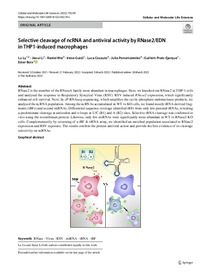Benvinguts al Repositori Digital de la UPF
Genome analysis of five recently described species of the CUG-Ser clade uncovers Candida theae as a new hybrid lineage with pathogenic potential in the Candida parapsilosis species complex
JavaScript is disabled for your browser. Some features of this site may not work without it.
Mostra el registre parcial de l'element
| dc.contributor.author | Mixão, Verónica de Pinho, 1991- |
| dc.contributor.author | del Olmo, Valentina |
| dc.contributor.author | Hegedűsová, Eva |
| dc.contributor.author | Saus Martínez, Ester |
| dc.contributor.author | Pryszcz, Leszek Piotr, 1985- |
| dc.contributor.author | Cillingová, Andrea |
| dc.contributor.author | Nosek, Jozef |
| dc.contributor.author | Gabaldón Estevan, Juan Antonio, 1973- |
| dc.date.accessioned | 2022-05-25T10:14:46Z |
| dc.date.available | 2022-05-25T10:14:46Z |
| dc.date.issued | 2022 |
| dc.identifier.citation | Mixão V, Del Olmo V, Hegedűsová E, Saus E, Pryszcz L, Cillingová A et al. Genome analysis of five recently described species of the CUG-Ser clade uncovers Candida theae as a new hybrid lineage with pathogenic potential in the Candida parapsilosis species complex. DNA Res. 2022 Feb 27;29(2):dsac010. DOI:10.1093/dnares/dsac010 |
| dc.identifier.issn | 1340-2838 |
| dc.identifier.uri | http://hdl.handle.net/10230/53259 |
| dc.description.abstract | Candida parapsilosis species complex comprises three important pathogenic species: Candida parapsilosis sensu stricto, Candida orthopsilosis and Candida metapsilosis. The majority of C. orthopsilosis and all C. metapsilosis isolates sequenced thus far are hybrids, and most of the parental lineages remain unidentified. This led to the hypothesis that hybrids with pathogenic potential were formed by the hybridization of non-pathogenic lineages that thrive in the environment. In a search for the missing hybrid parentals, and aiming to get a better understanding of the evolution of the species complex, we sequenced, assembled and analysed the genome of five close relatives isolated from the environment: Candida jiufengensis, Candida pseudojiufengensis, Candida oxycetoniae, Candida margitis and Candida theae. We found that the linear conformation of mitochondrial genomes in Candida species emerged multiple times independently. Furthermore, our analyses discarded the possible involvement of these species in the mentioned hybridizations, but identified C. theae as an additional hybrid in the species complex. Importantly, C. theae was recently associated with a case of infection, and we also uncovered the hybrid nature of this clinical isolate. Altogether, our results reinforce the hypothesis that hybridization is widespread among Candida species, and potentially contributes to the emergence of lineages with opportunistic pathogenic behaviour. |
| dc.description.sponsorship | This work received funding from the European Union’s Horizon 2020 Research and Innovation Program under the Marie Skłodowska-Curie Grant Agreement No. H2020-MSCA-ITN-2014-642095. T.G. group also acknowledges support from the Spanish Ministry of Science and Innovation for grant PGC2018-099921-B-I00, cofounded by European Regional Development Fund (ERDF); from the Catalan Research Agency (AGAUR) SGR423; from the European Union’s Horizon 2020 research and innovation programme (ERC-2016-724173); from the Gordon and Betty Moore Foundation (Grant GBMF9742) and from the Instituto de Salud Carlos III (INB Grant PT17/0009/0023—ISCIII-SGEFI/ERDF). J.N. group was supported by the Slovak Research and Development Agency (APVV-18-0239, APVV-20-0166) and the Scientific Grant Agency of the Ministry of Education, Science, Research and Sport of the Slovak Republic (VEGA 1/0027/19) |
| dc.format.mimetype | application/pdf |
| dc.language.iso | eng |
| dc.publisher | Oxford University Press |
| dc.rights | © Verónica Mixão et al. 2022. Published by Oxford University Press on behalf of Kazusa DNA Research Institute. This is an Open Access article distributed under the terms of the Creative Commons Attribution License (https://creativecommons.org/licenses/by/4.0/), which permits unrestricted reuse, distribution, and reproduction in any medium, provided the original work is properly cited |
| dc.rights.uri | https://creativecommons.org/licenses/by/4.0/ |
| dc.subject.other | Genòmica |
| dc.subject.other | Càndida |
| dc.title | Genome analysis of five recently described species of the CUG-Ser clade uncovers Candida theae as a new hybrid lineage with pathogenic potential in the Candida parapsilosis species complex |
| dc.type | info:eu-repo/semantics/article |
| dc.identifier.doi | http://dx.doi.org/10.1093/dnares/dsac010 |
| dc.relation.projectID | info:eu-repo/grantAgreement/EC/H2020/642095 |
| dc.relation.projectID | info:eu-repo/grantAgreement/EC/H2020/724173 |
| dc.rights.accessRights | info:eu-repo/semantics/openAccess |
| dc.type.version | info:eu-repo/semantics/publishedVersion |


